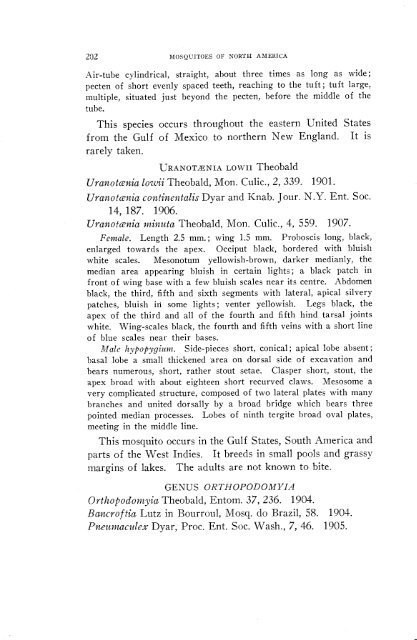a handbook of the mosquitoes of north america - Systematic Catalog ...
a handbook of the mosquitoes of north america - Systematic Catalog ...
a handbook of the mosquitoes of north america - Systematic Catalog ...
Create successful ePaper yourself
Turn your PDF publications into a flip-book with our unique Google optimized e-Paper software.
202 MOSQUITOES OF NORTH AMERICA<br />
Air-tube cylindrical, straight, about three times as long as wide;<br />
pecten <strong>of</strong> short evenly spaced teeth, reaching to <strong>the</strong> tuft; tuft large,<br />
multiple, situated just beyond <strong>the</strong> pecten, before <strong>the</strong> middle <strong>of</strong> <strong>the</strong><br />
tube.<br />
This species occurs throughout <strong>the</strong> eastern United States<br />
from <strong>the</strong> Gulf <strong>of</strong> Mexico to nor<strong>the</strong>rn New England. It is<br />
rarely taken.<br />
URANOTBNIA LOCVII Theobald<br />
Uranotmsia Zowii Theobald, Mon. Culic., 2, 339. 1901.<br />
Uranotmia continestalis Dyar and Knab. Jour. N.Y. Ent. Sot.<br />
14, 187. 1906.<br />
Uranotmia mimta Theobald, Mon. Culic., 4, 559. 1907.<br />
Female. Length 2.5 mm.; wing 1.5 mm. Proboscis long, black,<br />
enlarged towards <strong>the</strong> apex. Occiput black, bordered with bluish<br />
white scales. Mesonotum yellowish-brown, darker medianly, <strong>the</strong><br />
median area appearing bluish in certain lights; a black patch in<br />
front <strong>of</strong> wing base with a few bluish scales near its centre. Abdomen<br />
black, <strong>the</strong> third, fifth and sixth segments with lateral, apical silvery<br />
patches, bluish in some lights; venter yellowish. Legs black, <strong>the</strong><br />
apex <strong>of</strong> <strong>the</strong> third and all <strong>of</strong> <strong>the</strong> fourth and fifth hind tarsal joints<br />
white. Wing-scales black, <strong>the</strong> fourth and fifth veins with a short line<br />
<strong>of</strong> blue scales near <strong>the</strong>ir bases.<br />
Male laypopygizm. Side-pieces short, conical ; apical lobe absent ;<br />
basal lobe a small thickened area on dorsal side <strong>of</strong> excavation and<br />
bears numerous, short, ra<strong>the</strong>r stout setae. Clasper short, stout, <strong>the</strong><br />
apex broad with about eighteen short recurved claws. Mesosome a<br />
very complicated structure, composed <strong>of</strong> two lateral plates with many<br />
branches and united dorsally by a broad bridge which bears three<br />
pointed median processes. Lobes <strong>of</strong> ninth tergite broad oval plates,<br />
meeting in <strong>the</strong> middle line.<br />
This mosquito occurs in <strong>the</strong> Gulf States, South America and<br />
parts <strong>of</strong> <strong>the</strong> West Indies. It bsreeds in small pools and grassy<br />
margins <strong>of</strong> lakes. The adults are not known to bite.<br />
GENUS ORTHOPODOMYIA<br />
Orthopodomyia Theobald, Entom. 37, 236. 1904.<br />
Bancr<strong>of</strong>tia Lutz in Bourroul, Mosq. do Brazil, 58. 1904.<br />
Pnezmaculex Dyar, Proc. Ent. Sot. Wash., 7, 46. 1905.

















